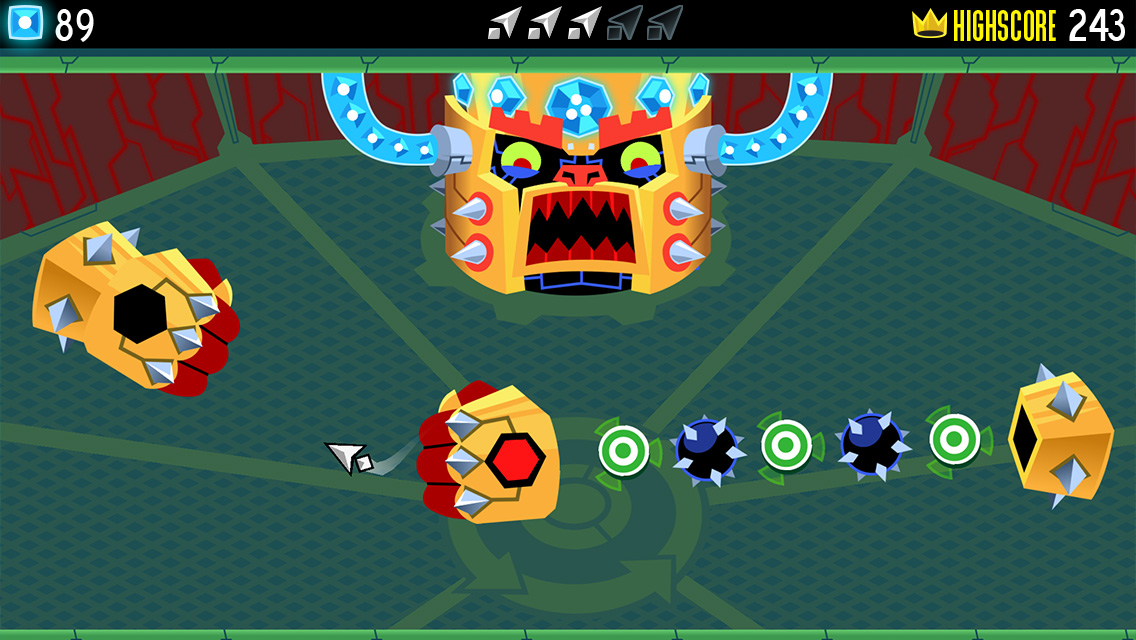Sure, sometimes developers can give reasons for why they want to charge more money for something that are utter poppycock. Granted, I’ve known One Man Left since 2010, and I take them at their word that Tilt to Live: Gauntlet’s Revenge ($2.99) was becoming too big and too separate to be just an add-on to Tilt to Live 2 ($2.99). But in playing it, I think the position is really quite justified. This is pretty much its own game, only filtered through Tilt to Live‘s aesthetics and controls. And it winds up being this challenging gauntlet that’s well worth checking out.
This is the gauntlet mode from the original Tilt to Live ($2.99) for iPhone taken to a further degree. The shared element is that the screen is constantly scrolling forward, and players have multiple lives to use in order to stay alive, but now there’s three different sets of gauntlets to take on. Lockdown is perhaps the most familiar, with the knives that come flying in from outside the screen like in the original Gauntlet mode, and traps that largely consist of turrets and moving gate-like obstacles to pass through.
While the differences start there, Pointonium Mines starts to introduce lasers, flying enemies with targets that drop pointonium crystals that serve as the measure of success beyond just progression, and switches that must be used to pass through. Arropolis has more flying enemies, robots that will fly around pursuing the player’s arrow, and tricky spinning knife and spike formations. While the Tilt to Live 2 visual style makes this feel a lot different, the only thing really tying this in to Tilt to Live is the arrow itself. Otherwise, this is pretty much a new game!
And Gauntlet’s Revenge really does a good job at being this kind of challenge that needs a lot of practice to do well at. It’s the kind of game where any one obstacle might be navigable, but have to deal with three of them at the same time? Good luck with that. But it really is just a matter of practicing, as each obstacle can be survived – it’s just about getting better at avoiding the situations where lives are lost to stupid mistakes, and learning how to mitigate multiple threats at once. Just beating any gauntlet on normal is a tall order, much less on hard when there’s only one life.
I must give a tip: there will be a temptation to skip the easy difficulty. After all, I imagine many people reading this are dyed-in-the-wool gamers, and will think that normal is the way to go, easy is for suckers. No – play easy as well, in part because it will serve as a perfect introduction to the various traps in each section of the game, but also because it’s kind of rewarding to actually succeed. Then, once they’re all conquered, normal mode becomes a viable proposition. Thankfully, the checkpoints help out a lot, and getting lives refilled at each one makes it a much easier to complete each gauntlet in one shot. It’s still remarkably difficult, but there’s a reason why I use the comparative there.
The pointonium adds an additional layer of challenge, as there’s no record for time survived, collecting these crystals serves as the only method determining comparative success. These crystals often come at a risk to collect them, as they often come in at the most dangerous spots, and valuable ones only temporarily available before disappearing. Some enemies drop crystals as well, so high scores almost become a second game entirely – if the first is about survival, the second is about taking risks to get high scores. Of course, just getting to that point is hard enough as it is!
One Man Left continue their unabated streak of warlockery when it comes to making great tilt controls. There’s the familiar array of standard, top-down, and custom calibration options that make this game much more playable than ever. But more than anything else that the series has done, this game actually makes the controls and the inherent inaccuracy of tilting a key part of the game. This game would be easier if there was a joystick of some sort moving the arrow around, sure. But it’s just part of the game’s objective that tilting is inherently inaccurate, and has that physical aspect where trying to dodge something requires actually moving the device to get out of the way.
I despise games with poor controls. There’s a reason why I never fell in love with Resident Evil 4 the way everyone else did, and why Metroid Prime remains supremely overrated to me. But Tilt to Live: Gauntlet’s Revenge may be hard to accurately control, it’s not due to incompetence or putting up an artificial layer, it’s integrating a specific input type into how it plays in order to be part of the difficulty that everyone has to take on. It’s like how Dance Dance Revolution feels totally different with a dance pad versus a controller.
I definitely recommend that Tilt to Live fans check out Gauntlet’s Revenge: it’s really quite different from even the Gauntlet mode you know from the original Tilt to Live, but for fans of the series’ style and tilting gameplay, this is a fresh way of enjoying things that will prove to be a real test.



